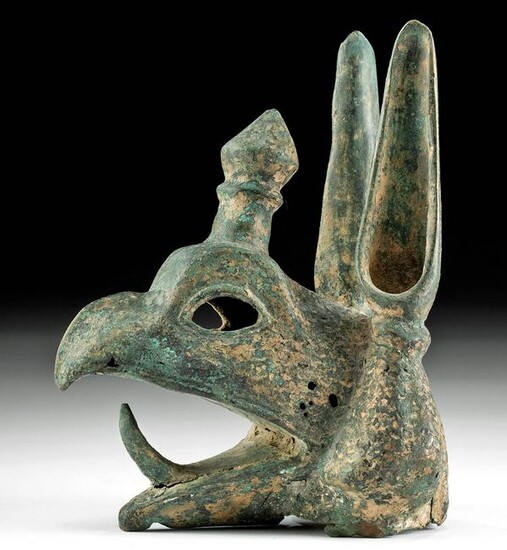Greek Archaic Bronze Protome Cast as Griffin
Ancient Greece, Archaic Period, ca. 7th to 6th century BCE. A striking bronze protome cast as a griffin, with the head of an eagle and incised scales and open beak with curled, pointed tongue. The eyes are openwork with raised eyelines around the lobes which may have contained bone inlays. A finial with a knob is set on the brow, and further back on the head are dramatic, pointed ears. This griffin head perhaps rested atop a sinuous neck that attached to the side of a cauldron. The griffin (or gryphon) is a beast with the head and wings of an eagle and the body of a lion. According to Graeco-Roman mythology, griffins lived in the Rhipaean Mountains of Scythia and guarded rich gold deposits. A wonderful green patina envelops this fantastical beast. Size: 5" L x 3.5" W x 5.8" H (12.7 cm x 8.9 cm x 14.7 cm)
The griffin, half eagle and half lion, was a fierce symbol of divine power. The tradition was long lasting - we know of examples from ancient Iran and Egypt that are from ca. 3000 BCE - and the animal continued to appear in classically-inspired art into the early modern period.
Offerings to gods often consisted of impressive bronze vessels or cauldrons that were embellished by protomes featuring guardian heads riveted to the rims.
For a similar example please see the Metropolitan Museum of Art, accession number: 59.11.18.
This piece has been searched against the Art Loss Register database and has been cleared. The Art Loss Register maintains the world’s largest database of stolen art, collectibles, and antiques.
Provenance: private New York, USA collection; ex-private collection, acquired on the German art market in 2001
All items legal to buy/sell under U.S. Statute covering cultural patrimony Code 2600, CHAPTER 14, and are guaranteed to be as described or your money back.
A Certificate of Authenticity will accompany all winning bids.
PLEASE NOTE: Due to recent increases of shipments being seized by Australian & German customs (even for items with pre-UNESCO provenance), we will no longer ship most antiquities and ancient Chinese art to Australia & Germany. For categories of items that are acceptable to ship to Australia or Germany, please contact us directly or work with your local customs brokerage firm.
Display stands not described as included/custom in the item description are for photography purposes only and will not be included with the item upon shipping.
#164981
Condition Report: Fragment of a larger piece as shown. Perforations and piercings through sides, mouth and top. Mineral and earthen deposits on interior and exterior. Surface pitting and chips to high pointed areas. Great preservation of overall form and rich green patina.
View it on
Estimate
Time, Location
Auction House
Ancient Greece, Archaic Period, ca. 7th to 6th century BCE. A striking bronze protome cast as a griffin, with the head of an eagle and incised scales and open beak with curled, pointed tongue. The eyes are openwork with raised eyelines around the lobes which may have contained bone inlays. A finial with a knob is set on the brow, and further back on the head are dramatic, pointed ears. This griffin head perhaps rested atop a sinuous neck that attached to the side of a cauldron. The griffin (or gryphon) is a beast with the head and wings of an eagle and the body of a lion. According to Graeco-Roman mythology, griffins lived in the Rhipaean Mountains of Scythia and guarded rich gold deposits. A wonderful green patina envelops this fantastical beast. Size: 5" L x 3.5" W x 5.8" H (12.7 cm x 8.9 cm x 14.7 cm)
The griffin, half eagle and half lion, was a fierce symbol of divine power. The tradition was long lasting - we know of examples from ancient Iran and Egypt that are from ca. 3000 BCE - and the animal continued to appear in classically-inspired art into the early modern period.
Offerings to gods often consisted of impressive bronze vessels or cauldrons that were embellished by protomes featuring guardian heads riveted to the rims.
For a similar example please see the Metropolitan Museum of Art, accession number: 59.11.18.
This piece has been searched against the Art Loss Register database and has been cleared. The Art Loss Register maintains the world’s largest database of stolen art, collectibles, and antiques.
Provenance: private New York, USA collection; ex-private collection, acquired on the German art market in 2001
All items legal to buy/sell under U.S. Statute covering cultural patrimony Code 2600, CHAPTER 14, and are guaranteed to be as described or your money back.
A Certificate of Authenticity will accompany all winning bids.
PLEASE NOTE: Due to recent increases of shipments being seized by Australian & German customs (even for items with pre-UNESCO provenance), we will no longer ship most antiquities and ancient Chinese art to Australia & Germany. For categories of items that are acceptable to ship to Australia or Germany, please contact us directly or work with your local customs brokerage firm.
Display stands not described as included/custom in the item description are for photography purposes only and will not be included with the item upon shipping.
#164981
Condition Report: Fragment of a larger piece as shown. Perforations and piercings through sides, mouth and top. Mineral and earthen deposits on interior and exterior. Surface pitting and chips to high pointed areas. Great preservation of overall form and rich green patina.



